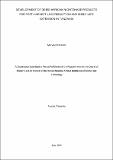Development of dried African nightshade products for post-harvest loss reduction and shelf-life extension in Tanzania
Abstract
African nightshade (ANS) is a luminary food plant, considered a cheap and potential dietary
source for micronutrients and bioactive compounds. Lack of value addition on ANS, results
to high availability of ANS during peak season and shortage in off-season was the great demand
for developing dried products. This study evaluated the effects of drying techniques on
nutritional (minerals & vitamin C) and anti-nutritional (oxalate & phytate) contents of Solanum
scabrum (SS) and S. villosum (SV). Three methods of drying namely indirect solar drying
(ISD), mixed solar drying (MSD), and open sun drying (OSD) were employed. Furthermore,
blanching (85°C, 2 min) with and without 3% salt (NaCl) were used as pre-treatments for ANS.
The effect of pre-treatment methods on nutrient retention and anti-nutrients removal was also
recorded. From the results ISD was the most effective method for vitamin C (14.76% 19.2%),
Ca (92.90%, 96.57%), Fe (77.88%, 71.54%), and Zn (86.94%, 90.09%) retention for both SS
and SV leaves, respectively. On the other hand, all drying methods significantly reduced levels
of oxalate (4.46% to 35.24% ) and phytate (52.12% to 85.55%). Pannelists rated dried ANS
significantly ≤ 0.05 higher for texture, colour, taste, aroma, bitterness and overall acceptability.
Shelf life studies of dried products were stable at ambient and refrigeration storage for a period
of three months with no growth of bacteria, yeast and mold, with significance loss of Vitamin
C under both conditions. The findings showed that the ISD best method for vitamin C, minerals
retention and anti-nutritional reduction.

